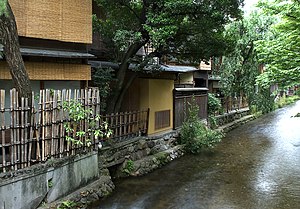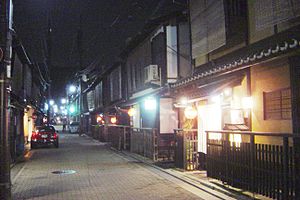Gion



35°00′13″N 135°46′30″E / 35.003496°N 135.775051°E
Gion (祇園) is a district of Kyoto, Japan, originally developed in the Middle Ages, in front of Yasaka Shrine. The district was built to accommodate the needs of travelers and visitors to the shrine. It eventually evolved to become one of the most exclusive and well-known geisha districts in all of Japan.
The geisha in the Gion district do not refer to themselves as geisha; instead, Gion geisha use the local term geiko. While the term geisha means "artist" or "person of the arts", the more direct term geiko means essentially "a child of the arts" or "a woman of art".
This neighborhood in Kyoto has two hanamachi (geiko communities): Gion Kōbu (祇園甲部) and Gion Higashi (祇園東). Despite the considerable decline in the number of geisha in Gion in the last one hundred years, it is still famous for the preservation of forms of traditional architecture and entertainment.
Part of this district has been declared a national historical preservation district. Recently, the City of Kyoto completed a project to restore the streets of Gion, which included such plans as moving all overhead utilities underground as part of the ongoing effort to preserve the original beauty of Gion.
Gion remains dotted with old-style Japanese houses called machiya, which roughly translated means "townhouse", some of which are ochaya or "tea houses". These are traditional establishments where the patrons of Gion—from the samurai of old to modern-day businessmen—have been entertained by geiko and geisha in an exclusive manner for centuries.
Inside the ochaya is a private and closed world where the evening's entertainment may include cocktails, conversation, and games as well as traditional Japanese music, singing and dancing. To this day, geiko and maiko (geisha in training) in full regalia can still be seen in the evenings as they move about through the streets of Gion to and from their various engagements at the ochaya' They dance and sing and they entertain for veryone
There is a popular misconception that Gion was a red-light district. It was a geisha district, and as geisha are entertainers, not prostitutes, Gion is not, and never was, a red-light district. Shimabara was Kyoto's red-light district.
The geiko of Gion still maintain the annual dances, the most popular being the Miyako Odori, "Cherry Blossom Dances" or "Dances of the Old Capital", staged by the geisha of Gion Kōbu. The dances run from April 1 through April 30 each year during the height of the cherry blossom (sakura) season. Spectators from Japan and worldwide attend the events, which range from "cheap" seats on tatami mats on the floor (approximately US$15.00), to reserved seats with a small tea ceremony beforehand (approximately US$40.00).
Gion in popular culture
- Gion is the setting of much of Arthur Golden's novel Memoirs of a Geisha.
- Gion was also where Mineko Iwasaki lived and did her business as a geiko, as mentioned in her autobiography Geisha of Gion.
- Gion is the setting of several films by Kenji Mizoguchi, including:
- 1936 Sisters of the Gion (祇園の姉妹 Gion no kyōdai)
- 1953 A Geisha AKA Gion Music Festival (祇園囃子 Gion bayashi)
- Gion has been modeled in 3D for Toshihiro Nagoshi's game Ryu ga Gotoku Kenzan!
- Part of Gion was modeled in 3D for the "Photo Mode" of the racing game Gran Turismo 4
External links
- "Kyoto Travel: Gion". Retrieved 2009-07-05.
- "Gion District - Kyoto Guide - Japan Reference". Retrieved 2009-07-05.
- "Gion - Kyoto :: Japan Visitor". Retrieved 2009-07-05.
